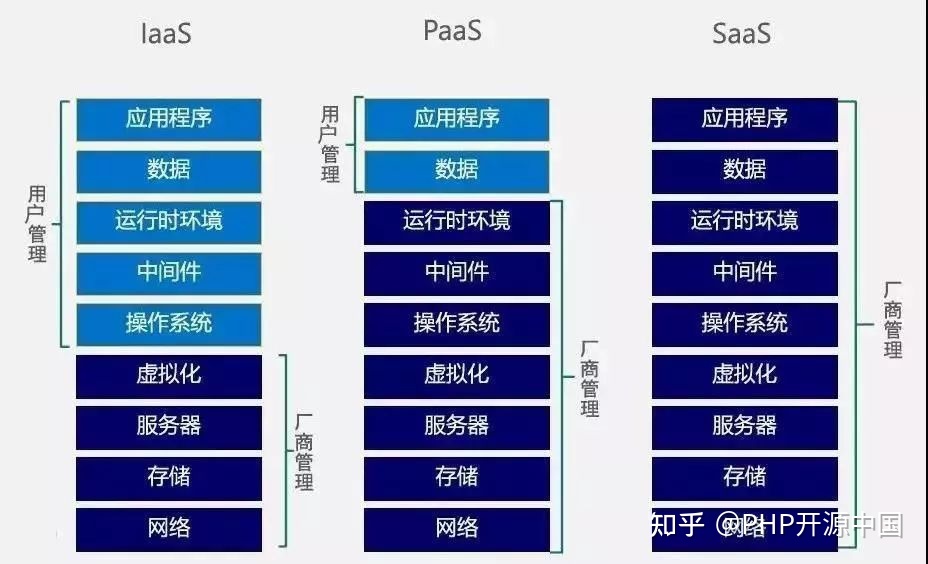1. Understanding cloud computing from the perspective of technical concepts
Early cloud computing was distributed computing on virtualized hosts. At this stage, cloud computing is not just a kind of distributed computing, but distributed computing, utility computing, load balancing, parallel computing, network storage, hot backup The result of the mixed evolution and leap of computer technologies such as redundancy and virtualization . Cloud computing is not a new network technology, but a new network concept.
Technologies involved in cloud computing include:
- Virtualization technology: realize resource pooling and elastic expansion through software and hardware decoupling, such as KVM
- Distributed technology: distributed storage, distributed database, distributed cache, distributed message queue
- Cloud-native technology: Containers, microservices, and DevOps are known as the cloud-native troika, and they are important components to realize the technology platform. Containers are a very lightweight virtualization technology that can be deployed in seconds. The main idea is to package once and run everywhere. The microservice architecture is a sublimation of SOA, decoupling applications into more lightweight, independent, autonomous, agile development, deployment and governance services that can be accessed through HTTP. DevOps is agile development and maintenance. Through continuous integration and continuous deployment of CICD and other automated tools and processes, it connects all links of application development, testing, release, and operation and maintenance to greatly improve system efficiency and reliability.
- Cloud security technology: Cloud security involves host security, network security, application security, business security, data security, etc. All vendors have relatively mature products and technologies in related fields.
- Cloud management platform: Cloud management usually involves four levels: one is tenant-side management, allowing users to effectively manage and use basic cloud services; the other is operation management, which involves cloud service operation strategies, such as resource management, metering and billing, and message notification etc.; the third is operation and maintenance management: it involves the availability and reliability guarantee of the cloud platform, such as automatic operation and maintenance, monitoring and alarming, operation and maintenance troubleshooting, etc. The fourth is multi-cloud management. For many enterprises, hybrid cloud is currently a trend, private cloud + public cloud, or the introduction and balancing of multiple cloud vendors. Therefore, it is necessary to provide a management platform that can manage multiple clouds and traditional IT environments in a unified manner. OpenStack is an open source cloud management platform. Each cloud vendor has its own management and control platform. There are also some vendors that specialize in multi-cloud management, such as Boyun, Qianyun, and Feizhiyun.
2. Cloud Computing Services
Cloud computing is a disruptive delivery model , an integrated shared service platform . From a technical point of view, it is to integrate all the servers, storage and other infrastructure and networks of the enterprise into a unified cloud platform. In the "cloud world", technology and business are combined and delivered to users. The operation management and decision-making analysis of enterprises will be carried out based on the cloud platform, and people will live a kind of "life on the cloud". It is a system, an overall concept, and an integrated concept of business and technology integration, which is very important for understanding the cloud.
1. Classification of cloud computing services
Classification by cloud computing service level :
- SaaS (Software as a Service, Software as a Service): Provide various application software services
- PaaS (Platform as a Service, Platform as a Service): Provide software support platform services
- IaaS (Infrastructure as a Service): Provides computing resources and infrastructure services close to bare metal (physical or virtual)

Classified by Cloud Computing System Type :
- Public Cloud : Provides cloud computing services for the general public and public groups, such as Amazon Cloud Platform and Google AppEng. The public cloud has many advantages, but the biggest disadvantage is that it is difficult to ensure the privacy of data.
- Private Cloud : Provide cloud computing services for application industries/organizations such as government agencies, mobile communications, and schools for internal use. Private cloud can better solve the problem of data privacy. For enterprises or institutions with particularly high data privacy requirements such as mobile communications and public security, building a private cloud will be an inevitable choice.
- Community cloud : Provide a cloud computing platform for users in community organizations, such as the Nebula cloud platform of NASA to provide rapid IT access services for researchers in NASA.
- Hybrid Cloud : A hybrid cloud platform that includes more than two cloud computing types above
2. Cloud Computing Architecture Design
What are the core technologies of cloud computing_Service_System_Data
3. Provide cloud computing services
1. Alibaba Cloud
Official Documentation: Alibaba Cloud Documentation_Documentation Center_Cloud Computing Documentation-Alibaba Cloud Help Center
Some concepts:
- RAM (Resource Access Management) user identity management and resource access control services. You can create and manage user accounts (such as employees, systems, or applications) through RAM, and control the operation permissions of these user accounts on resources under your name.
- ECS (Elastic Compute Service) is an IaaS (Infrastructure as a Service) level cloud computing service provided by Alibaba Cloud with excellent performance, stability, reliability, and elastic expansion. ECS cloud server components:

References
[1] Article from 2014: GitHub - zangree/InTheCloud: An introductory/advanced manual for cloud computing.
[2] Cyber Security Technology Roadmap: Cyber Security Roadmap: Learn to become a Cyber Security Expert
[7] Build web and mobile applications - Azure Architecture Center | Microsoft Learn